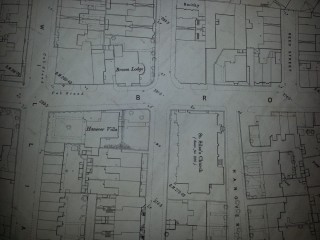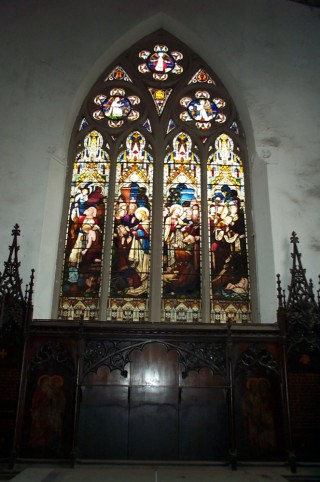The Consecration of St Silas Church, Broomhall
From the Sheffield Independent newspaper ~ 6th Feb 1869
Transcribed by Joey Xu
This newspaper article is a fascinating insight into the opening of St Silas church in 1869. Before that the local congregation met in the Gillcar school room on Hodgson Street and before that in the Debtor’s Gaol on Thomas Street.
“The new church, dedicated to St. Silas, at the crossing of Broomhall and Hanover Streets, in what is known as the Gillcar District, was consecrated by his Grace the Archbishop of York, yesterday afternoon. The church is the gift of Mr. Henry Wilson, and is the second church he has built in Sheffield within the last ten or twelve years. The cost is between £7000 and £8000. The church consists of a nave 80 feet long, by 27 feet wide, north and south aisles, and spacious chancel, on the one side of which are the organ chapel and the vestry, and on the other seats for the Sunday school children.
The tower is at the corner of Hanover and Broomhall streets, and is terminated by eight pinnacles, the total height from the ground being 94 feet. The belfry stage is ornamented with eight windows, the arches of which are supported by clusters of columns. The cornice is richly foliaged with conventional ornaments, and there are gargoyle at the angles; the lower part forms a spacious porch. There are no galleries to the church, but the floor furnishes accommodation for 800 persons. The nave arches are simple and massive in treatment, carried on circular columns, with shafts of conventional foliage carved with great and varnished, and the free-sitting plan will be adopted in regard to them. The chancel in fitted with and elaborated carved oak reredos, communion table, screens, and choir stalls; and on the reredos are painted the unusual representations of the four Evangelists, and the usual accompaniments of the Ten Commandments, the Lord’s Prayer, and the Creed.
The chancel is paved with black and red tiles, manufactured by Messrs Maw; the roof is waggon headed in form, a construction said to be suited to bring out the voices of the choristers. The pulpit and reading desk are of oak, richly carved. The church is lighted at the west end by a five-light window, and at the cast end by a four-light window, but the clerestory windows were mainly relied upon, and altogether abundant light is admitted into every part of the church. The roof is of open timber work—red deal and pitch pine boarded and stained. The height of the church from the floor to the apex of the roof is about 55 feet. Artificial light is afforded in the nave by gas brackets upon the arches, in the aisles by small coronas, and in the chancel by two highly wrought brass standards. The church is warmed by means of Messrs. Stuart and Smith’s (Sheffield) Gill stove. The architects are Messrs. Blackmoor and the work was given to Messrs. Badger and Holmes. The church is a pleasing object externally, and its handsome internal appearance excited general admiration yesterday.
The consecration service began at three o’clock, before which time the church was densely crowded. There was a numerous array of the clergy, arrayed according to their individual tastes, either in the black gown or the surplice.
The ARCHBISHOP preached from Leviticus xvi. 34: “And this shall be an everlasting statute unto you to make an atonement for the children of Israel for all their sins once a year.” He described the ceremony of the Day of Atonement, and its prefiguring of the sacrifice of Christ, and showed how, as the Mosaic dispensation neared its close, the contrition, humility, and penetrating sense of the majesty and purity of God, that peculiarly belonged to the observances of the Day of Atonement, seemed totally wanting among the Jewish people. The lines of the Covenant between them and God grew more and more obscured, the hedges that separated them from other nations were broken down; their teachers were a time-serving High Priest who depended for his office upon his subserviency to the Roman Governor, and whose very robes for the Day of Atonement were kept by his Roman masters, and the Pharisees, who were saturated with hypocrisy and notorious for their pride and hardness of heart.
The preacher then showed how Christ was the great Atonement, how the veil of the Temple was rent at his death to show that the Holy of Holies, heaven itself, was no longer closed against man, how, though the ceremonies and sacrifices of the Temple still continued, the smoke of the offerings no longer came up before God, and how the 40 years that elapsed before the carrying out of the sentence passed by Christ on the Temple that there should not be left one stone upon another were but a respite, while the destroying storm was all the while gathering over the doomed nation and city. At the close of the sermon, he made the following remarks upon the occasion which had drawn them together. He said they were engaged in the performance of a solemn act, they were setting apart a church for God, and it was decent and right so to do. That setting apart of one room for one purpose, and another for another, prevailed in their houses, and the setting apart of a house for the special worship of God commended itself to their feelings of decency and order, if to nothing higher. It was not that any virtue resided in the temple; it was a beautiful gift that they were taking possession of, but if they made the beauty tenfold greater, they would not thereby come any nearer to the King.
It was not because of its beauty that the house of God was hallowed by His presence, but because people brought, as formerly on the Day of Atonement, a sense of humility on account of sin, and a wish to be reconciled to God by that which alone could reconcile them, the death and loving mediation of Christ. If they were to make that a day of real consecration, let them consecrate themselves. If they wanted to receive again the sacrifices that once were offered, let them bring out their calf of sin and slay it there before the Lord. If they wanted to give something precious in his sight they could not do it by gold or silver, by sculptured stones or carved wood; there was one thing which they ought to think vile, but which God was pleased to think precious, the soul that they possessed; let them bring hat and offer it to Him, it was there reasonable service.
The whole of religion, what was it? It was not to keep order in a town that ministers of religion gave themselves to their work it was not to cause children to be well taught instead of letting them remain ignorant that laymen and ministers built and opened schools. These might follow, but the business of religion was to sir up and revive in men’s minds that which the Day of Atonement taught, a sense o separation between them, the children, and God, the Father, which would get wider and deeper, unless they threw themselves on His mercy, and begged Him to lead them as children that could not take care of themselves. It was the business of ministers of religion to stir up in the mind of men the feeling that they dared not live, no, not for an hour in the state of men upon whom God’s face was vent in wrath—a feeling that if here was way of escape from this horrible position they ought to seek it, and neither to eat nor drink, nor sleep, as it were, until they had found it. He would ask his hearers, and especially those of hem that belonged to that district, to consider what they had that day been doing.
There was a person in the congregation who, seeing the need of those around him, and loving them for Christ’s sake, had given them that church and asked for nothing whatever in return. If any gratitude was to be shown to him, it was to be shown in their appreciation of his gift by crowding into the church and showing in warm and fervent worship how glad they were to find, as it were, a new gate on the road to Christ. He trusted that might be the result of the day’s service, for what could be more sad and more deplorable than for him to come back after a few years and find that a great experiment had been tried in vain; but what, on the other hand, would be more encouraging and more cheering than for him to find that house crowded with earnest and serious minded people, who felt it good to come into God’s presence and hear afresh the promise that He could and would forgive, to pray for grace for themselves, and to pour forth out of eager hearts the praise of God Most High! Before they left that house he would ask them to offer a prayer for the giver of the church, and to pray that all the thousands who dwelt around it and refused Christ might be brought to understand that they were sinners, and that Christ had shown them the way to forgiveness, and to look up with confidence into the face of their Father.
A collection was made for the organ fund, amounting to £40.12s. 2d., and collections will also be made at the church for the same purpose next Sunday morning and evening, when sermons will be preached by the Rev. Dr Sale and the Rev. C. S. Wright.”
Researched on the British Newspaper Archive website











No Comments
Add a comment about this page